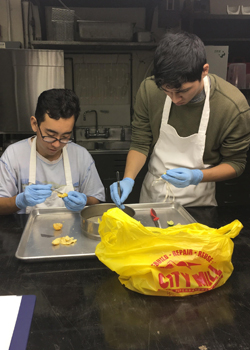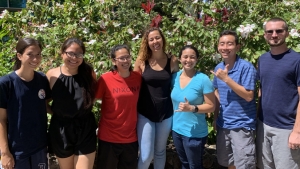
Flavonoid compounds (products extracted from plants) are antioxidants and some have been shown to have nutraceutical and medicinal roles such as antiviral, anti-cancer, anti-inflammatory and anti-allergic activities. In an effort to examine how flavonoid compounds are produced in plants, specifically in citrus species, an assistant professor at the University of Hawaiʻi at Mānoa’s College of Tropical Agriculture and Human Resources (CTAHR), received $876,213 from a National Science Foundation CAREER award over the next five years.
Daniel Owens’ research contributes directly to an understanding of how compounds are produced in plants and can be used to improve both quality and marketability of agriculture products.
Citrus flavonoids directly influence taste characteristics. For example, they are responsible for the bitterness of a grapefruit compared to the sweetness of an orange, and the unique crimson color associated with blood orange varieties compared to the more common blonde varieties in oranges. Therefore, increasing the amount of flavonoid compounds in citrus fruit and fruit derivatives (juices, jams, jellies, etc.) has the potential to make citrus products healthier options for the consumer and increase profits for producers.

Although there has been some success in breeding and other techniques to increase the amount of desired compounds, having a 3D understanding of biosynthesis (the production of chemical compounds by a living organism) will improve success in these areas. Additionally, the findings can be extended beyond citrus plants to other crop plants.
“Our work is unique in that we are beginning to examine the pathways that produce flavonoids in 3D by examining complexes called metabolons,” said Owens. “Traditional biochemical approaches establish the individual procedures in a biosynthetic pathway, and essentially establish a 2D blueprint of the steps involved. We are going a step beyond this to determine how these individual components interact within the cell to produce compounds. In other words, we are going beyond the 2D blueprint and beginning to examine the 3D assembly line that is produced from it.”
Researchers are also examining how enzymes are involved in the overall biosynthetic process by adding sugars and other types of chemical groups to the core of the compounds.
Population growth outpacing agricultural production
It has been a long-held concern that worldwide population growth is outpacing agricultural production. This has fueled an upsurgence of interest in sustainable practices and the need to increase the levels of crop production.
“This is of even greater concern for island populations, like Hawaiʻi, which must import most of our food from mainland locations,” said Owens. “One component greatly contributing to this issue is the decrease in the number of farmers and of young people entering agricultural fields. By educating young students on the exciting technical advances in modern agriculture and giving them the opportunity to experience the pride associated with growing their own food, I hope to lead some of them to actively pursue agricultural careers.”

Funding will support undergraduate and graduate student researchers, purchasing equipment, and operational costs and supplies. Educational and outreach goals in Honolulu public schools include teaching students about the opportunities provided by modern agriculture and providing them experience in growing edible plants.
“I have been lucky to have a number of wonderful mentors during my career, and I hope to be able to pay back the community for all the opportunities I have been given by helping along the next generation of agriculturists, scientists and professionals,” added Owens.
This research is an example of UH Mānoa’s goal of Excellence in Research: Advancing the Research and Creative Work Enterprise (PDF), one of four goals identified in the 2015–25 Strategic Plan (PDF), updated in December 2020.

